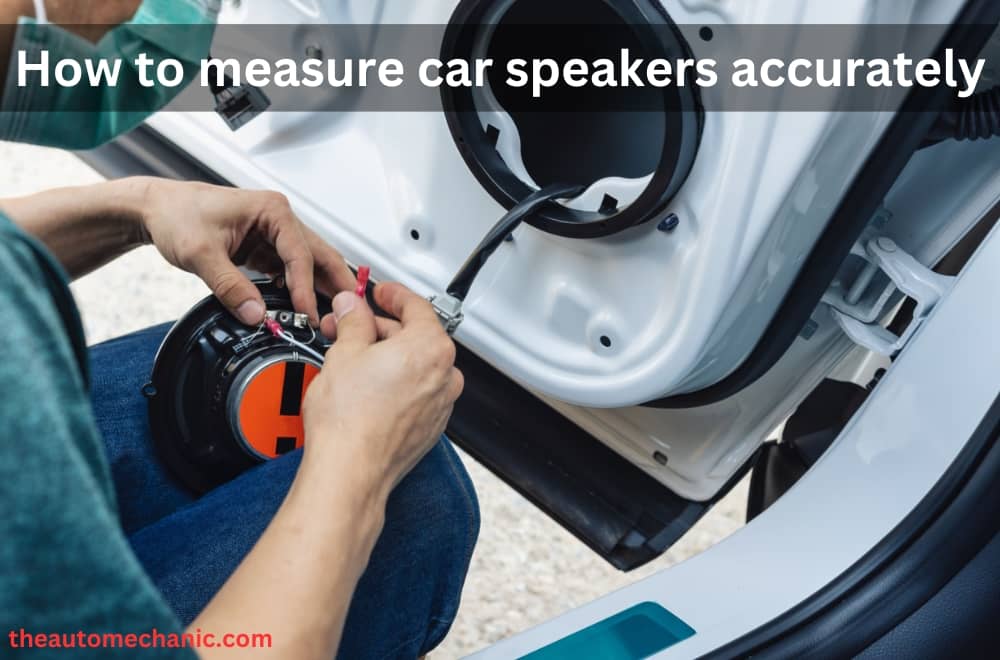This becomes a regrettable choice after buying a new set of speakers, and in most cases, glancing leads to choosing the wrong side of the speaker.
Thus, you must measure the existing speakers accurately to select the correct set. There are various terms related to measuring a speaker.
Understanding each term is crucial. In this blog, you will learn how to measure a speaker correctly and how to make car speakers louder without an amp. Let us start without further delay.
Is it important to know how many speakers are in my car?
Yes, counting the number of speakers in the car is highly beneficial. It tells you about the different types of speakers in the car and makes you aware of the size of the speakers required in the car.
Equipment required
How do you measure car speakers effectively? You can do that with the equipment mentioned below.
- Measuring tape
- Pen and paper
- Screwdriver
- Drill machine
- Panel opener
Steps- How To Measure Car Speakers
Dismantle
First, you must remove the speakers from the car. If you have counted the speakers in my car, you must know the required time.
You need to ensure you do not damage any wire or component of the car. Thus, carefully dismantle the speakers from the car. Mark the wires of the speakers and keep them separate. Also, avoid losing the nuts and bolts.
Body
There are two ways how to measure car speakers. The first measures the body/bracket in which the speakers will be installed.
The second measures the speaker, which we will discuss in the upcoming sections. Usually, there are two types of speaker structures.
The first one consists of a single-diameter hole. You need to measure the diameter from one end to the other.
Moreover, measure the bracket’s depth from the mounting plane. The second type of bracket has two diameters: the outer diameter and the inner diameter.
The internal diameter is also known as the recessed diameter. Measure both, including the mounting depth, to choose the correct type of speaker.
Speaker Of A Car
This is the most accurate way to measure car speakers. As mentioned below, you need to measure certain sections. Make sure that you use a highly accurate measuring tape.
Wide front
Look at the speaker from the front. The widest diameter visible is known as the wide front. Does measuring it help during replacement? Yes, the wide front of a speaker determines the mounting height after installation.
Cut out diameter
Now flip the speaker so that the magnet faces you. You will observe a cone attached to the mounting frame.
The widest diameter of this cone is known as the cut-out diameter. It determines whether or not the speaker will match the inner diameter of the bracket.
Mounting Depth
The mounting depth is the vertical distance between the mounting frame and the speaker’s magnet.
To measure it, place the speaker on a horizontal surface parallel to the mounting frame and magnet. Then, measure the speaker’s vertical height.
Mounting Height
This is the most challenging part of measuring car speakers. Simply, it is the vertical height or thickness of the mounting frame.
A large mounting height can lead to bumping things with the speaker. Make sure that the mounting frame does not stick out. Thus, choose a speaker with a low mounting height.
The shape of the speaker
Various speaker shapes are available in the market, including circles, ovals, and rectangles. Most car owners buy speakers with a different shape than the existing ones.
You must choose a speaker with the same shape as the previous one. The other shapes won’t fit in that bracket.
Tips for measuring car speakers
Double-check
You must measure every section of the speaker at least two times to avoid errors in the measurement. Usually, the diameter of a speaker is expressed in decimals like 5.56 inches, 6.89 inches, and many more. This becomes more crucial when you measure the mounting height.
Proper installation
Lastly, you must ensure you install or dismantle the speaker properly. Sometimes, even the right speaker does not fit due to improper installation.
Tips on how to make car speakers louder without the amp
- Play high-quality music files. In most cases, the sound quality through the speaker is bad due to the quality of the music file. However, some people fail to understand that and end up changing the speaker. How can you identify the quality of music files? Simple: The quality of every music file is defined in kbps. 356 kbps is the finest music file.
- Use the equalizer to control the quality of the music. Almost every stereo system comes with an in-built equalizer. In many cases, the equalizer is OFF by default. You need to turn it ON and change the bass and other settings to meet your expectations.
- Adding tweeters can also be useful in making the audio system louder. Have you never heard of tweeters? Well, they are the smallest car speakers, specifically designed to improve audio quality. You can install them at various places, such as doors, dashboards, luggage spaces, etc.
- You may even increase the number of speakers in the market. Overall, this will improve the quality of the audio system.
- You can even add a few woofers to the car to improve the quality of the speakers. Woofers are the largest and loudest speakers for cars. However, we recommend installing these speakers in the luggage space.
- The last tip is to reduce the engine noise. Sometimes, the engine’s sound is louder than the audio system. To this end, you can install a sound-reducing layer around the engine.
Conclusion
Now you know the most effective method for measuring car speakers. We chose these tips based on our intense research and experience with car speakers.
Let us recap a few of them. You must measure the speaker’s height, depth, diameter, and every dimension.
We have already discussed terms like mounting depth, height, cut-off diameter, and many more. If you measure the bracket, make sure that you measure the inner and outer diameters.
Moreover, you need to uninstall the speakers properly before measuring them. You must choose a highly accurate measuring tape and measure each section at least twice. Lastly, select high-quality replacements.

Bruce William is a professional content writer and vehicle engineer with extensive car maintenance and repair knowledge. His expertise spans all vehicle parts, offering practical solutions for various automotive issues. Bruce provides valuable insights through his website articles to help readers maintain their cars for optimal performance and longevity.

